#Python loop syntax
Explore tagged Tumblr posts
Text
Day-5: Mastering Python Loops
Python Boot Camp-2023: Day-5
Python Loop: A Powerful Tool for Iterative Tasks Python, one of the most popular programming languages, offers a wide range of features and functionalities. Among these, loops stand out as a powerful tool for performing repetitive tasks. In this article, we’ll explore Python loops, their types, usage, and best practices to optimize your code. 1. Introduction to Python Loops Loops are essential…

View On WordPress
#Iterative tasks in Python#List comprehensions in PythonPython loop best practices#Python coding efficiency#Python database interactions#Python for loop#Python loop examples#Python loop optimization#Python loop performance#Python loop syntax#Python loop tutorial#Python loops#Python nested loops#Python programming tips#Python while loop
0 notes
Text
Second part of the giga-ask compilation!
@publicuniversalworstie asked: Why assume the Horrorterrors would know that changing events would create a doomed timeline? That assumes both A) that the horrorterrors know the future and B) that they don't think it can really be changed. Maybe they genuinely thought they could change things, such as by perhaps fulfilling all the requisite loops a different way? Imagine a scenario where a time traveler learns of their death, therefore being destined to die, and instead fake their death to create the conditions under which they learned of the death originally.
It's possible. But if the Horrorterrors do have a way to trick the Alpha Timeline like that, then they've really been holding out on us by not mentioning it to the Players. Such a revelation would completely change the game - we might even be able to fake the Earth's death.
Anonymous asked: i want to learn more about coding to analyze homestuck better - do you have a place i could start? resources? idk love the liveblog hope you're doin well :]
Absolutely! I've got two separate answers for you, depending on what your goal is here.
If your main goal is just to analyse Homestuck, then you’re probably best off picking a language whose syntax is easy to understand, such as Python. You'll pick up on the basic logic pretty quickly, and the ~ATH snippets will start to make a lot more sense.
If you’re actually interested in programming for its own sake, then I recommend you start with my own first language, C. It’s a lot harder for a newbie to get to grips with, but doing so will give you a much more solid theoretical foundation then ostensibly ‘easier’ languages.
W3schools is a decent starting resource for both languages - but if you need more specific guidance, let me know, and I'd be happy to help!
@skelekingfeddy asked: actually grubmom having the same color wires as in that pic of sahlee wasnt intentional! i based it on how sollux’s game grubs have red and blue wires attached to them
Serendipity!
Anonymous asked: Did you run any mysterious ~ath programs on that computer of yours?
Honestly, running ATH on that thing would probably have improved it.
Anonymous asked: One voice headcanon I have for Terezi is the English dub of Power from Chainsaw man
Honestly, she sounds pretty much exactly how I imagine Terezi does. She even has the horns!
@martinkhall asked: I'm surprised none of the suggested instruments for a time player were an ocarina.
Some fruit is just too low-hanging.
@delicate-ruins asked: what's an animal you like that you think doesn't show up very much in media, be it fiction or news or just generally? example: i like secretary birds. but except for videos about them, i have never heard them references.

They're not obscure, per se, but there will never be enough sloths in media. The only fictional sloth of note is Sid from Ice Age – and he does not do them justice.

Capybaras are also underrated as hell – so much so that LibreOffice, which I'm using to edit this compilation, doesn’t even recognize the word as real!
Anonymous asked: “I’m trying to figure out if it’s fully a Breath outfit, or if there’s some Heir stuff too.” the general rule for god tier outfits is that the colors and symbol represent the aspect, the clothes represent the class. so, for example, if two princes of different aspects ascended, their clothing style would be the same but they would a have different color scheme. @skaiandestiny asked: If you haven't already figured it out, class informs the godtier outfit and aspect informs the colors and icon!
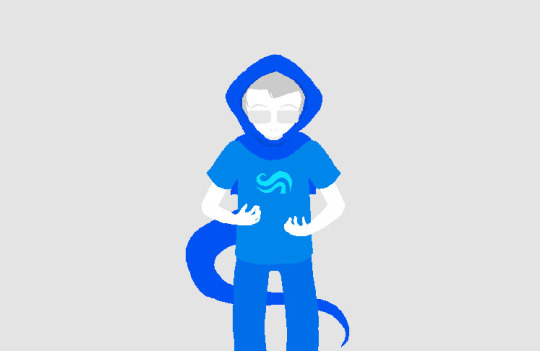
In that case, there is something about John’s outfit that says ‘heir’ – but nothing really stands out to me.
@driventopoison asked: Hey, I don't know if it's just me but it seems like you've skipped ahead. I have been following your liveblog daily, but I haven't seen you come across the windy thing yet. Is this because you were using the app or something? Also just want to let you know that I love your liveblog. Keep up the good work!
Thank you! Anyway, John’s Windy Thing is indeed documented on the liveblog, and it’s visible to me. I was using the app for some of that segment, though – are app-made posts particularly buggy?
@classpecting-guide-official asked: story about a modded game of sburb where the characters notice that something isn't right and slowly realize that their world is a lie
Back in Act 1, this is pretty much what I thought was happening. It was a simpler time.
@ignis-cain asked: Note the colors the capslock flashes for WV.

When WV locks his capsule, the button’s light flashes red and green – but I’m not sure what the significance of these colors is, in this situation.
Anonymous asked: i know i'm SUPER late to answer this, but i think the instantiation thing is the same as any video game, newly made with a prebaked history. when you name your character, that has been their name for their whole life, even though you thought it up a few seconds ago. when you enter the medium, the planet has a history and the denizens have memories, even though they just showed up when you entered.
Yeah, I’m pretty sure this is indeed what’s going on. The implications are just a lot more wild when the game is physically real, rather than virtual!
@kintatsu asked: So, I know I'm a little late to the party, but I have to point out: Alternian sunlight doesn't need to be THAT much stronger than Earth's to blind Terezi as quickly as it did. Trolls are nocturnal, which means they almost definitely have a tapetum lucidum (eyeshine membrane), which means that however much light entered Terezi's eyeballs? Her retinas were blasted by every photon twice.

Damn, Vriska. For a second, I thought this ask was explaining why Terezi wasn't in as much pain as I'd thought - but this alternate explanation might actually be worse than what I was picturing!
@delicate-ruins asked: It's delightful to see somebody read Homestuck and be as charmed by it as I and a lot of my friends were way back when we first read it, and the calm, digesting pace at which you're enjoying it is honestly so nice. I rushed way too much to catch up since my friends recommended it in about 2016, which means I went from knowing nothing about the comic to being caught up on it in like a week. I never sat down with the ideas and thought "hey, does this mean XYZ?" because quite often I got the answer five seconds later as I rushed to catch up. But seeing you asking those questions is so so fun. Yeah, DOES it mean that?? Guess we'll find out! In the meantime, we get to guess, which means we basically get to have fun twice. It's reigniting my enjoyment of homestuck quite significantly, I think!
Thank you! It’s really nice to be able to engage in a dialogue about the comic through these asks, which is something that wouldn't be possible if I was speeding through it. As I always say, I'm here for a good time and a long time.
@manorinthewoods asked: Alright, here's another transtimeline fun fact. Each of the kids was supposed to have a Quest related to their associated material - John had a land covered in oil, Rose's ocean was polluted with chalk, the gears of LOHAC were gummed by amber, and LOFAF was in a nuclear winter. Ultimately, while the ocean of LOLAR is still chalky, nothing but John's oil made the cut. ~LOSS (16/5/23)
I think it was a good change, then. Not everything has to be a pattern, and Dave's two weird maybe-quests are a lot more unique and interesting than a generic 'materials quest'.
@captorations asked: oh hey, this walkaround! so funny story, i used to run a blog where i posted one of terezi’s canon appearances each day, in order. yes, i completed my task, and more besides. however! when i was wandering through this as terezi, a glitch rendered me trapped. i decided that this counted as a noteworthy appearance, and took a screenshot. then, by sheer coincidence, it ended up being posted on… halloween. it was pretty great (also don’t forget to check out ctrl + t)
You accessed the double-secret version of Past Karkat: Wake Up, which plays the Earthbound Halloween Hack version of Megalovania rather than the Homestuck one.
Anonymous asked: Personally, I think John gaining so many levels so quickly is tied to his role as the heir - he gains so many levels without really trying, not because he's better than the trolls or his friends, but because he just kind of falls into it. The game rewards him for taking the path of least resistance.
That certainly makes sense if we just look at John - but I have trouble reconciling this interpretation with our other Heir. Equius certainly has some advantages, but they aren't exactly unique to him, as you'd expect them to be if his Heir class was responsible for them.
Yes, he's a highblood, but he's outranked by three non-Heirs - and his strength doesn't seem to be unique either, as Feferi seems capable of similar feats. Perhaps Equius will trip and fall into more unique privilege, but it hasn't happened yet.
Anonymous asked: my personal headcanons for midnight crew claspects: Slick - Prince of Blood, Droog - Mage of Space, Boxcars - Knight of Heart, Deuce - Bard of Doom. knowing you youre probably gonna attempt to analyse these LOL
Slick has had ties to Blood since he first met Karkat, so that tracks - and Boxcars is a shipper, so Nepeta's aspect is probably the best fit for now. I'm not sure about the other two, but I'll revisit them later!
74 notes
·
View notes
Text
CAFFEINE, CODE, AND COUCH CONFESSIONS



Warnings: coffee addiction
Tim Drake, the resident tech genius of Wayne Manor, had a mission: to teach you the intricacies of coding. Armed with a whiteboard, a stack of textbooks, and a steely determination, he embarked on this noble quest. Little did he know that unraveling the mysteries of Python and JavaScript would be the least challenging part.
Tim sat you down in the cozy corner of the Batcave, the glow of the Batcomputer casting shadows on his face. He explained loops, variables, and functions with the fervor of a preacher. But your brain? It was like a stubborn old laptop running Windows 95—slow, glitchy, and prone to crashing.
"Okay, so if you have a nested loop," Tim said, pointing at the whiteboard, "you'll need to—"
You interrupted. Again. "Wait, wait. What's a nested loop? Is it like a Russian doll situation?"
Tim sighed, rubbing his temples. "No, it's not—"
"But what if the Russian doll is an array?" you asked, eyes wide.
Tim's patience wavered. "It's not—"
"But what if the array contains Batman's utility belt gadgets?" you persisted.
He pinched the bridge of his nose. "That's not—"
Coding fatigue set in. Tim's eyes glazed over as you continued your relentless questioning. He needed a distraction—a break from the syntax and semicolons. So, he proposed a truce: "How about we take a snack break?"
You perked up. "Snacks? Now you're speaking my language."
Soon, the Batcave echoed with the rustling of chip bags and the clinking of coffee mugs. Tim brewed a fresh pot of coffee—the fifth one that day—and you raised an eyebrow.
"Tim, you're going to turn into a jittery metahuman," you warned.
He grinned, sipping from his mug. "Nah, I've built up a tolerance."
The couch beckoned, its cushions inviting. Tim abandoned the whiteboard, and you both sank into its plush embrace. Laptops forgotten, you fired up the gaming console. The Batcave's massive screen displayed the latest multiplayer shooter.
"Ready to kick some virtual butt?" you asked, controller in hand.
Tim hesitated. "Actually, can we watch movies instead?"
You raised an eyebrow. "Movies? Since when do you—"
"—binge-watch romantic comedies?" Tim finished, cheeks flushing. "I may or may not have a soft spot for cheesy love stories."
And so, you traded code for rom-coms, coffee for popcorn. Tim's head found its way to your lap, and you stroked his hair absentmindedly.
"Promise me," you said, "no more coffee. Your heart rate is rivaling the Bat-Signal."
He grumbled but complied. "Fine. But only because you're the best code-cracking partner."
As the credits rolled on the screen, Tim whispered, "Maybe I'll write an algorithm to predict our next movie choice."
You chuckled. "Or we could just flip a coin."
And there, in the dim glow of the Batcave, you realized that maybe—just maybe—love was the most complex code of all.
#yn#spotify#x reader#viralpost#batfam#x yn#tim drake#timothy drake#red robin#batboy#tim drake x reader#tim drake x y/n
138 notes
·
View notes
Text
Python for Beginners: Launch Your Tech Career with Coding Skills
Are you ready to launch your tech career but don’t know where to start? Learning Python is one of the best ways to break into the world of technology—even if you have zero coding experience.
In this guide, we’ll explore how Python for beginners can be your gateway to a rewarding career in software development, data science, automation, and more.
Why Python Is the Perfect Language for Beginners
Python has become the go-to programming language for beginners and professionals alike—and for good reason:
Simple syntax: Python reads like plain English, making it easy to learn.
High demand: Industries spanning the spectrum are actively seeking Python developers to fuel their technological advancements.
Versatile applications: Python's versatility shines as it powers everything from crafting websites to driving artificial intelligence and dissecting data.
Whether you want to become a software developer, data analyst, or AI engineer, Python lays the foundation.
What Can You Do With Python?
Python is not just a beginner language—it’s a career-building tool. Here are just a few career paths where Python is essential:
Web Development: Frameworks like Django and Flask make it easy to build powerful web applications. You can even enroll in a Python Course in Kochi to gain hands-on experience with real-world web projects.
Data Science & Analytics: For professionals tackling data analysis and visualization, the Python ecosystem, featuring powerhouses like Pandas, NumPy, and Matplotlib, sets the benchmark.
Machine Learning & AI: Spearheading advancements in artificial intelligence development, Python boasts powerful tools such as TensorFlow and scikit-learn.
Automation & Scripting: Simple yet effective Python scripts offer a pathway to amplified efficiency by automating routine workflows.
Cybersecurity & Networking: The application of Python is expanding into crucial domains such as ethical hacking, penetration testing, and the automation of network processes.
How to Get Started with Python
Starting your Python journey doesn't require a computer science degree. Success hinges on a focused commitment combined with a thoughtfully structured educational approach.
Step 1: Install Python
Download and install Python from python.org. It's free and available for all platforms.
Step 2: Choose an IDE
Use beginner-friendly tools like Thonny, PyCharm, or VS Code to write your code.
Step 3: Learn the Basics
Focus on:
Variables and data types
Conditional statements
Loops
Functions
Lists and dictionaries
If you prefer guided learning, a reputable Python Institute in Kochi can offer structured programs and mentorship to help you grasp core concepts efficiently.
Step 4: Build Projects
Learning by doing is key. Start small:
Build a calculator
Automate file organization
Create a to-do list app
As your skills grow, you can tackle more complex projects like data dashboards or web apps.
How Python Skills Can Boost Your Career
Adding Python to your resume instantly opens up new opportunities. Here's how it helps:
Higher employability: Python is one of the top 3 most in-demand programming languages.
Better salaries: Python developers earn competitive salaries across the globe.
Remote job opportunities: Many Python-related jobs are available remotely, offering flexibility.
Even if you're not aiming to be a full-time developer, Python skills can enhance careers in marketing, finance, research, and product management.
If you're serious about starting a career in tech, learning Python is the smartest first step you can take. It’s beginner-friendly, powerful, and widely used across industries.
Whether you're a student, job switcher, or just curious about programming, Python for beginners can unlock countless career opportunities. Invest time in learning today—and start building the future you want in tech.
Globally recognized as a premier educational hub, DataMites Institute delivers in-depth training programs across the pivotal fields of data science, artificial intelligence, and machine learning. They provide expert-led courses designed for both beginners and professionals aiming to boost their careers.
Python Modules Explained - Different Types and Functions - Python Tutorial
youtube
#python course#python training#python#learnpython#pythoncourseinindia#pythoncourseinkochi#pythoninstitute#python for data science#Youtube
3 notes
·
View notes
Text
Why Learning Python is the Perfect First Step in Coding
Learning Python is an ideal way to dive into programming. Its simplicity and versatility make it the perfect language for beginners, whether you're looking to develop basic skills or eventually dive into fields like data analysis, web development, or machine learning.
Start by focusing on the fundamentals: learn about variables, data types, conditionals, and loops. These core concepts are the building blocks of programming, and Python’s clear syntax makes them easier to grasp. Interactive platforms like Codecademy, Khan Academy, and freeCodeCamp offer structured, step-by-step lessons that are perfect for beginners, so start there.
Once you’ve got a handle on the basics, apply what you’ve learned by building small projects. For example, try coding a simple calculator, a basic guessing game, or even a text-based story generator. These small projects will help you understand how programming concepts work together, giving you confidence and helping you identify areas where you might need a bit more practice.
When you're ready to move beyond the basics, Python offers many powerful libraries that open up new possibilities. Dive into pandas for data analysis, matplotlib for data visualization, or even Django if you want to explore web development. Each library offers a set of tools that helps you do more complex tasks, and learning them will expand your coding skillset significantly.
Keep practicing, and don't hesitate to look at code written by others to see how they approach problems. Coding is a journey, and with every line you write, you’re gaining valuable skills that will pay off in future projects.
FREE Python and R Programming Course on Data Science, Machine Learning, Data Analysis, and Data Visualization
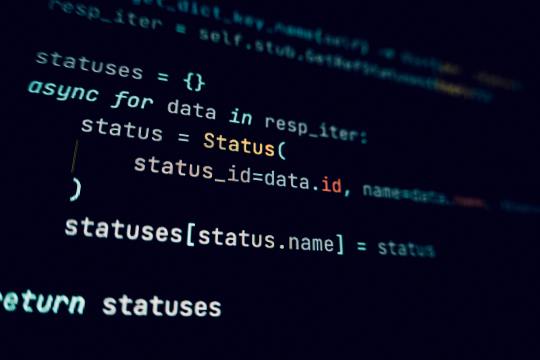
#learntocode#python for beginners#codingjourney#programmingbasics#web development#datascience#machinelearning#pythonprojects#codingcommunity#python#free course
10 notes
·
View notes
Text
On one hand, I hate my robotics teacher for teaching us the same lesson on python loops we've been learning for half the damn school year, then expecting us to make an innovative robot in 3 weeks when arduino is based on C++.
I was gonna counter that with something else, but as I wrote it I realized just how stupid it actually is. Fuck it. Venting time.
NO CUZ I CAN'T UNDERSTAND THIS GUY. WDYM "Programming's easy! You learn the basics, and from there you make your own solutions." ??? That's not verbatim but. STILL.
I'll give him a bit of credit, he taught us the basics of arduino. The proper syntax, loops, variables, functions, motor control, sensors, etc. But for god's sake, that limited pool of knowledge can only get you enough to make a mini car! It would've been nice to learn about fading LEDs, integer overflow, pointers vs the actual value in a variable, OR EVEN WHAT DOCUMENTATION IS. YEAH. DOCUMENTATION. THE LITERAL OFFICIAL EXPLANATION FOR KEY FEATURES IN PROGRAMMING LANGUAGES.
But suddenly its OUR fault our code doesn't work because "I taught you the basics. If you don't understand, that means you're not listening during my classes." MAYBE IF YOU STOPPED TEACHING US WHAT A FUCKING FOR LOOP IS, WE'D HAVE A REASON TO LISTEN. Majority of my understanding of robotics are a product of self study and receiving help from my family and their long list of IT contacts.
Not only that, HE is the one that approves of our robotics projects. If YOUR students can't complete the project YOU personally approved of, isn't that an error on your part? You should know what your students are capable of making. You should know because they should only know WHAT YOU TEACH THEM. So surprise surprise when your students feel like they're forced to hire people to do their projects, all because of your failure to teach them the skills they needed to do it themselves.
The only people getting a passing grade in this class are gonna be those that are either rich or have a lot of contacts. What a fucking joke.
And don't be mistaken, this is NOT the complaint of someone who doesn't understand programming. I consistently get 90% and above on his exams and do coding for fun. I'm complaining on behalf of my classmates who weren't as lucky as me, in that I have way more people to ask help from.
"100% working by this week" my ass. Actually teach us something relevant for once.
#dumb ramblings#vent post#ough#for the record i do like coding in python#i prefer it over C++ actually#But none of our projects use python#so I don't know what's going on in my teacher's head...
4 notes
·
View notes
Text
Python Programming Language: A Comprehensive Guide
Python is one of the maximum widely used and hastily growing programming languages within the world. Known for its simplicity, versatility, and great ecosystem, Python has become the cross-to desire for beginners, professionals, and organizations across industries.
What is Python used for

🐍 What is Python?
Python is a excessive-stage, interpreted, fashionable-purpose programming language. The language emphasizes clarity, concise syntax, and code simplicity, making it an excellent device for the whole lot from web development to synthetic intelligence.
Its syntax is designed to be readable and easy, regularly described as being near the English language. This ease of information has led Python to be adopted no longer simplest through programmers but also by way of scientists, mathematicians, and analysts who may not have a formal heritage in software engineering.
📜 Brief History of Python
Late Nineteen Eighties: Guido van Rossum starts work on Python as a hobby task.
1991: Python zero.9.0 is released, presenting classes, functions, and exception managing.
2000: Python 2.Zero is launched, introducing capabilities like list comprehensions and rubbish collection.
2008: Python 3.Zero is launched with considerable upgrades but breaks backward compatibility.
2024: Python three.12 is the modern day strong model, enhancing performance and typing support.
⭐ Key Features of Python
Easy to Learn and Use:
Python's syntax is simple and similar to English, making it a high-quality first programming language.
Interpreted Language:
Python isn't always compiled into device code; it's far done line by using line the usage of an interpreter, which makes debugging less complicated.
Cross-Platform:
Python code runs on Windows, macOS, Linux, and even cell devices and embedded structures.
Dynamic Typing:
Variables don’t require explicit type declarations; types are decided at runtime.
Object-Oriented and Functional:
Python helps each item-orientated programming (OOP) and practical programming paradigms.
Extensive Standard Library:
Python includes a rich set of built-in modules for string operations, report I/O, databases, networking, and more.
Huge Ecosystem of Libraries:
From data technological know-how to net development, Python's atmosphere consists of thousands of programs like NumPy, pandas, TensorFlow, Flask, Django, and many greater.
📌 Basic Python Syntax
Here's an instance of a easy Python program:
python
Copy
Edit
def greet(call):
print(f"Hello, call!")
greet("Alice")
Output:
Copy
Edit
Hello, Alice!
Key Syntax Elements:
Indentation is used to define blocks (no curly braces like in different languages).
Variables are declared via task: x = 5
Comments use #:
# This is a remark
Print Function:
print("Hello")
📊 Python Data Types
Python has several built-in data kinds:
Numeric: int, go with the flow, complicated
Text: str
Boolean: bool (True, False)
Sequence: listing, tuple, range
Mapping: dict
Set Types: set, frozenset
Example:
python
Copy
Edit
age = 25 # int
name = "John" # str
top = 5.Nine # drift
is_student = True # bool
colors = ["red", "green", "blue"] # listing
🔁 Control Structures
Conditional Statements:
python
Copy
Edit
if age > 18:
print("Adult")
elif age == 18:
print("Just became an person")
else:
print("Minor")
Loops:
python
Copy
Edit
for color in hues:
print(coloration)
while age < 30:
age += 1
🔧 Functions and Modules
Defining a Function:
python
Copy
Edit
def upload(a, b):
return a + b
Importing a Module:
python
Copy
Edit
import math
print(math.Sqrt(sixteen)) # Output: four.0
🗂️ Object-Oriented Programming (OOP)
Python supports OOP functions such as lessons, inheritance, and encapsulation.
Python
Copy
Edit
elegance Animal:
def __init__(self, call):
self.Call = name
def communicate(self):
print(f"self.Call makes a valid")
dog = Animal("Dog")
dog.Speak() # Output: Dog makes a legitimate
🧠 Applications of Python
Python is used in nearly each area of era:
1. Web Development
Frameworks like Django, Flask, and FastAPI make Python fantastic for building scalable web programs.
2. Data Science & Analytics
Libraries like pandas, NumPy, and Matplotlib permit for data manipulation, evaluation, and visualization.
Three. Machine Learning & AI
Python is the dominant language for AI, way to TensorFlow, PyTorch, scikit-research, and Keras.
4. Automation & Scripting
Python is extensively used for automating tasks like file managing, device tracking, and data scraping.
Five. Game Development
Frameworks like Pygame allow builders to build simple 2D games.
6. Desktop Applications
With libraries like Tkinter and PyQt, Python may be used to create cross-platform computing device apps.
7. Cybersecurity
Python is often used to write security equipment, penetration trying out scripts, and make the most development.
📚 Popular Python Libraries
NumPy: Numerical computing
pandas: Data analysis
Matplotlib / Seaborn: Visualization
scikit-study: Machine mastering
BeautifulSoup / Scrapy: Web scraping
Flask / Django: Web frameworks
OpenCV: Image processing
PyTorch / TensorFlow: Deep mastering
SQLAlchemy: Database ORM
💻 Python Tools and IDEs
Popular environments and tools for writing Python code encompass:
PyCharm: Full-featured Python IDE.
VS Code: Lightweight and extensible editor.
Jupyter Notebook: Interactive environment for statistics technological know-how and studies.
IDLE: Python’s default editor.
🔐 Strengths of Python
Easy to study and write
Large community and wealthy documentation
Extensive 0.33-birthday celebration libraries
Strong support for clinical computing and AI
Cross-platform compatibility
⚠️ Limitations of Python
Slower than compiled languages like C/C++
Not perfect for mobile app improvement
High memory usage in massive-scale packages
GIL (Global Interpreter Lock) restricts genuine multithreading in CPython
🧭 Learning Path for Python Beginners
Learn variables, facts types, and control glide.
Practice features and loops.
Understand modules and report coping with.
Explore OOP concepts.
Work on small initiatives (e.G., calculator, to-do app).
Dive into unique areas like statistics technological know-how, automation, or web development.
#What is Python used for#college students learn python#online course python#offline python course institute#python jobs in information technology
2 notes
·
View notes
Text
Struggling to learn python, not because I don't understand the syntax or the logic, but because every fucking exercise wants me to do math. A program that uses two loops to first set up a password and confirm it, and then asks for the password and locks you out if you failed 3 times? Easy peasy. A program asks you for 2 numerbs and prints out their sum? What the fuck is a +!?
4 notes
·
View notes
Text
What is Python, How to Learn Python?
What is Python?
Python is a high-level, interpreted programming language known for its simplicity and readability. It is widely used in various fields like: ✅ Web Development (Django, Flask) ✅ Data Science & Machine Learning (Pandas, NumPy, TensorFlow) ✅ Automation & Scripting (Web scraping, File automation) ✅ Game Development (Pygame) ✅ Cybersecurity & Ethical Hacking ✅ Embedded Systems & IoT (MicroPython)
Python is beginner-friendly because of its easy-to-read syntax, large community, and vast library support.
How Long Does It Take to Learn Python?
The time required to learn Python depends on your goals and background. Here’s a general breakdown:
1. Basics of Python (1-2 months)
If you spend 1-2 hours daily, you can master:
Variables, Data Types, Operators
Loops & Conditionals
Functions & Modules
Lists, Tuples, Dictionaries
File Handling
Basic Object-Oriented Programming (OOP)
2. Intermediate Level (2-4 months)
Once comfortable with basics, focus on:
Advanced OOP concepts
Exception Handling
Working with APIs & Web Scraping
Database handling (SQL, SQLite)
Python Libraries (Requests, Pandas, NumPy)
Small real-world projects
3. Advanced Python & Specialization (6+ months)
If you want to go pro, specialize in:
Data Science & Machine Learning (Matplotlib, Scikit-Learn, TensorFlow)
Web Development (Django, Flask)
Automation & Scripting
Cybersecurity & Ethical Hacking
Learning Plan Based on Your Goal
📌 Casual Learning – 3-6 months (for automation, scripting, or general knowledge) 📌 Professional Development – 6-12 months (for jobs in software, data science, etc.) 📌 Deep Mastery – 1-2 years (for AI, ML, complex projects, research)
Scope @ NareshIT:
At NareshIT’s Python application Development program you will be able to get the extensive hands-on training in front-end, middleware, and back-end technology.
It skilled you along with phase-end and capstone projects based on real business scenarios.
Here you learn the concepts from leading industry experts with content structured to ensure industrial relevance.
An end-to-end application with exciting features
Earn an industry-recognized course completion certificate.
For more details:
#classroom#python#education#learning#teaching#institute#marketing#study motivation#studying#onlinetraining
2 notes
·
View notes
Text
stream of consciousness about the new animation vs. coding episode, as a python programmer
holy shit, my increasingly exciting reaction as i realized that yellow was writing in PYTHON. i write in python. it's the programming language that i used in school and current use in work.
i was kinda expecting a print("hello world") but that's fine
i think using python to demonstrate coding was a practical choice. it's one of the most commonly used programming languages and it's very human readable.
the episode wasn't able to cram every possible concept in programming, of course, but they got a lot of them!
fun stuff like print() not outputting anything and typecasting between string values and integer values!!
string manipulation
booleans
little things like for-loops and while-loops for iterating over a string or list. and indexing! yay :D
* iterable input :D (the *bomb that got thrown at yellow)
and then they started importing libraries! i've never seen the turtle library but it seems like it draws vectors based on the angle you input into a function
the gun list ran out of "bullets" because it kept removing them from the list gun.pop()
AND THEN THE DATA VISUALIZATION. matplotlib!! numpy!!!! my beloved!!!!!!!! i work in data so this!!!! this!!!!! somehow really validating to me to see my favorite animated web series play with data. i think it's also a nice touch that the blue on the bars appear to be the matplotlib default blue. the plot formatting is accurate too!!!
haven't really used pygame either but making shapes and making them move based on arrow key input makes sense
i recall that yellow isn't the physically strongest, but it's cool to see them move around in space and i'm focusing on how they move and figure out the world.
nuke?!
and back to syntax error and then commenting it out # made it go away
cool nuke text motion graphics too :D (i don't think i make that motion in python, personally)
and then yellow cranks it to 100,000 to make a neural network in pytorch. this gets into nlp (tokenizers and other modeling)
a CLASS? we touch on some object oriented programming here but we just see the __init__ function so not the full concept is demonstrated here.
OH! the "hello world" got broken down into tokens. that's why we see the "hello world" string turn into numbers and then... bits (the 0s and 1s)? the strings are tokenized/turned into values that the model can interpret. it's trying to understand written human language
and then an LSTM?! (long short-term memory)
something something feed-forward neural network
model training (hence the epochs and increasing accuracy)
honestly, the scrolling through the code goes so fast, i had to do a second look through (i'm also not very deeply versed in implementing neural networks but i have learned about them in school)
and all of this to send "hello world" to an AI(?) recreation of the exploded laptop
not too bad for a macbook user lol
i'm just kidding, a major of people used macs in my classes
things i wanna do next since im so hyped
i haven't drawn for the fandom in a long time, but i feel a little motivated to draw my design of yellow again. i don't recall the episode using object oriented programming, but i kinda want to make a very simple example where the code is an initialization of a stick figure object and the instances are each of the color gang.
it wouldn't be full blown AI, but it's just me writing in everyone's personality traits and colors into a function, essentially since each stick figure is an individual program.
#animator vs animation#ava#yellow ava#ava yellow#long post#thank you if you took the time to read lol
5 notes
·
View notes
Text
Unlock the Power of Python Programming: A Complete Guide
Python programming has become one of the most sought-after skills in the world of technology. Its simplicity, flexibility, and vast ecosystem of libraries make it a top choice for both beginners and experienced developers. In this guide, we will explore various aspects of Python programming, from basic concepts to advanced applications like machine learning and web development.
Python Programming: A Beginner-Friendly Language
Python programming is renowned for its readability and straightforward syntax, making it ideal for beginners. Whether you are just starting to code or transitioning from another language, Python offers a smooth learning curve. Key Python programming concepts include variables, data types, and control structures, which are essential for writing functional code.
youtube
Python Data Structures: Organizing Data Efficiently
One of the core strengths of Python programming is its rich set of data structures. Lists, dictionaries, tuples, and sets help you store and manage data effectively. Understanding Python data structures allows you to create more efficient programs by organizing and manipulating data effortlessly.
Functions in Python Programming: Building Reusable Code
Functions are a fundamental part of Python programming. They allow you to break down complex problems into smaller, reusable chunks of code. Python functions not only promote code reusability but also make your programs more organized and easier to maintain.
Loops in Python Programming: Automating Repeated Tasks
Loops are an essential feature in Python programming, allowing you to perform repeated operations efficiently. With Python loops such as for and while, you can iterate over sequences or perform tasks until a specific condition is met. Mastering loops is a key part of becoming proficient in Python.
Object-Oriented Programming in Python: Structured Development
Python programming supports object-oriented programming (OOP), a paradigm that helps you build structured and scalable software. OOP in Python allows you to work with classes and objects, making it easier to model real-world scenarios and design complex systems in a manageable way.
Python Automation Scripts: Simplify Everyday Tasks
Python programming can be used to automate repetitive tasks, saving you time and effort. Python automation scripts can help with file management, web scraping, and even interacting with APIs. With Python libraries like os and shutil, automation becomes a breeze.
Python Web Development: Creating Dynamic Websites
Python programming is also a popular choice for web development. Frameworks like Django and Flask make it easy to build robust, scalable web applications. Whether you're developing a personal blog or an enterprise-level platform, Python web development empowers you to create dynamic and responsive websites.
APIs and Python Programming: Connecting Services
Python programming allows seamless integration with external services through APIs. Using libraries like requests, you can easily interact with third-party services, retrieve data, or send requests. This makes Python an excellent choice for building applications that rely on external data or services.
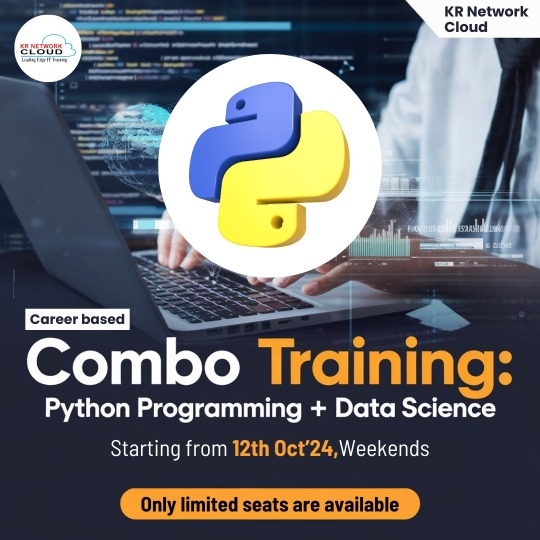
Error Handling in Python Programming: Writing Resilient Code
Python programming ensures that your code can handle unexpected issues using error handling mechanisms. With try-except blocks, you can manage errors gracefully and prevent your programs from crashing. Error handling is a critical aspect of writing robust and reliable Python code.
Python for Machine Learning: Leading the AI Revolution
Python programming plays a pivotal role in machine learning, thanks to powerful libraries like scikit-learn, TensorFlow, and PyTorch. With Python, you can build predictive models, analyze data, and develop intelligent systems. Machine learning with Python opens doors to exciting opportunities in artificial intelligence and data-driven decision-making.
Python Data Science: Turning Data Into Insights
Python programming is widely used in data science for tasks such as data analysis, visualization, and statistical modeling. Libraries like pandas, NumPy, and Matplotlib provide Python programmers with powerful tools to manipulate data and extract meaningful insights. Python data science skills are highly in demand across industries.
Python Libraries Overview: Tools for Every Task
One of the greatest advantages of Python programming is its extensive library support. Whether you're working on web development, automation, data science, or machine learning, Python has a library for almost every need. Exploring Python libraries like BeautifulSoup, NumPy, and Flask can significantly boost your productivity.
Python GUI Development: Building User Interfaces
Python programming isn't just limited to back-end or web development. With tools like Tkinter and PyQt, Python programmers can develop graphical user interfaces (GUIs) for desktop applications. Python GUI development allows you to create user-friendly software with visual elements like buttons, text fields, and images.
Conclusion: Python Programming for Every Developer
Python programming is a versatile and powerful language that can be applied in various domains, from web development and automation to machine learning and data science. Its simplicity, combined with its extensive libraries, makes it a must-learn language for developers at all levels. Whether you're new to programming or looking to advance your skills, Python offers endless possibilities.
At KR Network Cloud, we provide expert-led training to help you master Python programming and unlock your potential. Start your Python programming journey today and take the first step toward a successful career in tech!
#krnetworkcloud#python#language#programming#linux#exams#coding#software engineering#coding for beginners#careers#course#training#learning#education#technology#computing#tech news#business#security#futurism#Youtube
2 notes
·
View notes
Text
How much Python should one learn before beginning machine learning?
Before diving into machine learning, a solid understanding of Python is essential. :
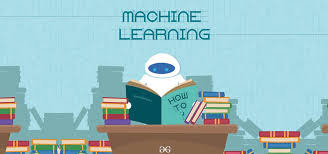
Basic Python Knowledge:
Syntax and Data Types:
Understand Python syntax, basic data types (strings, integers, floats), and operations.
Control Structures:
Learn how to use conditionals (if statements), loops (for and while), and list comprehensions.
Data Handling Libraries:
Pandas:
Familiarize yourself with Pandas for data manipulation and analysis. Learn how to handle DataFrames, series, and perform data cleaning and transformations.
NumPy:
Understand NumPy for numerical operations, working with arrays, and performing mathematical computations.
Data Visualization:
Matplotlib and Seaborn:
Learn basic plotting with Matplotlib and Seaborn for visualizing data and understanding trends and distributions.
Basic Programming Concepts:
Functions:
Know how to define and use functions to create reusable code.
File Handling:
Learn how to read from and write to files, which is important for handling datasets.
Basic Statistics:
Descriptive Statistics:
Understand mean, median, mode, standard deviation, and other basic statistical concepts.
Probability:
Basic knowledge of probability is useful for understanding concepts like distributions and statistical tests.
Libraries for Machine Learning:
Scikit-learn:
Get familiar with Scikit-learn for basic machine learning tasks like classification, regression, and clustering. Understand how to use it for training models, evaluating performance, and making predictions.
Hands-on Practice:
Projects:
Work on small projects or Kaggle competitions to apply your Python skills in practical scenarios. This helps in understanding how to preprocess data, train models, and interpret results.
In summary, a good grasp of Python basics, data handling, and basic statistics will prepare you well for starting with machine learning. Hands-on practice with machine learning libraries and projects will further solidify your skills.
To learn more drop the message…!
2 notes
·
View notes
Text
Morning python study log 03-11-2023
So these days I have started to stream my code study.
So today morning I learnt:
How to take absolute value. Found some anomaly in the system lol. Basically it was not taking abs() but fabs() however my python was the latest version
I studied how to sort three numbers in python, although I have done this in other language since the syntax of python is still foreign to me I had difficulty sorting them in ascending order and also descending order using the built in function sorted() and also making my own implementation
I understood what is range function and how to use it with for loops, had a bit of hit and miss while understanding how it really worked but google's bard helped, I also learnt about reverse sorting
I learnt what is interning while trying to understand the difference between identity operators and equality operators. Found some anomaly in my system again, that my computer's range of interning is much larger than what is documented ?
I learnt what is keyword argument when with using reverse built in sort, yeah so I was amazed that the order of arguments didn't mattered for keyword argument.
I was also confusing syntax of python with javascript since that is what is what recently code in.
Learnt about what does len() function does, like properly rather than just guessing about what it does.
understood about control statements such as if, else and elif
learnt about break and continue in loops in python which is same as java script.
learnt about how to check the divisibility of a number. I didn't knew that it was separate topic in my syllabus I just thought it was something people would knew.
Learnt the basics about on how to make a READ , EVAL PRINT LOOP, REPL
Learnt about stupid pattern program in python, I don't know why the heck they still teach these things and put it in syllabus. There is no real world use of it as far as I can see. I still have to post the notes about it in my blogs and store it my cloud drive.
Learnt how to do a summation of series, using and not using numpy.
figured out how to do a factorial of a number
was trying to make an short algorithm on how to do the fibonacci series but well, I was so sleepy that my mind didn't worked as it should, I took the hint from bard then felt bad that I was directly looking at the solution when rather I should sleep and approach the problem from afresh in next study stream. So stopped my study stream.
youtube
#programmer#studyblr#learning to code#python#coding#progblr#codeblr#programming#code log#study log#studying#Youtube
9 notes
·
View notes
Text
Exploring Python: Unveiling Its Features and Advantages
To begin learning Python, it's like starting an adventure. Imagine finding a special course that teaches you all about Python. This course should cover the basics like how to write the language, how to work with different types of information, and how to make your programs do things like repeat actions and remember stuff. But that's not all! It's like finding a treasure chest if the course also shows you more advanced ideas like building special kinds of programs, handling files, and using helpful tools that others have created.
From my own experience, it's like joining a team of ACTE that really know their stuff. They'll guide you through all the important things you need to know. They're so good that they even offer different ways of learning: you can learn with them in a classroom or even on the internet. And guess what? They even help you find a good job after you've learned a lot!
When you learn with them, it's like becoming a superhero who understands Python really well. You'll be able to use Python to create things in the real world, like games, apps, and more. I started my own adventure at ACTE Training Institute, and now I'm really skilled at using Python.
My own Python journey commenced at ACTE, enabling me to progress to an expert level. Here are key points to consider before commencing your Python learning experience:
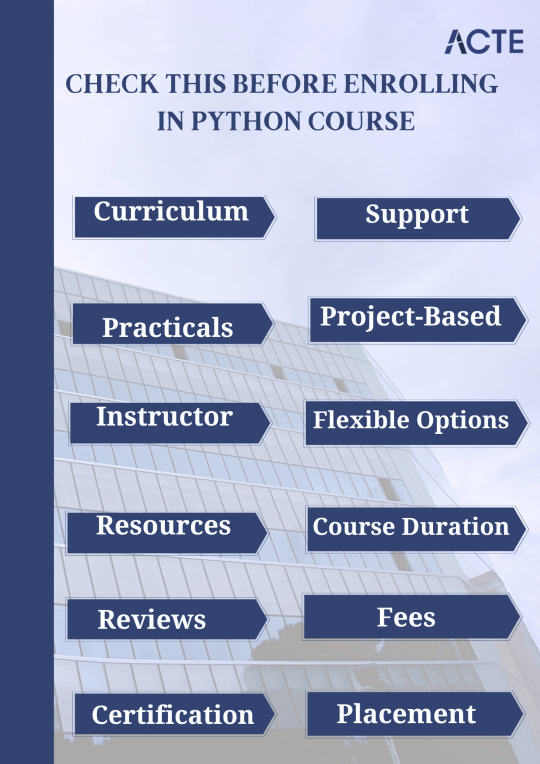
Course Content and Curriculum: A course that covers Python fundamentals comprehensively, encompassing topics from syntax and data types to loops, functions, and beyond. Advanced subjects like object-oriented programming and working with libraries should also be included.
Hands-on Practice: Practical exercises and coding assignments are crucial for reinforcing learning. Confirm that the course provides ample hands-on practice and projects to apply acquired knowledge.
Instructor Expertise: Evaluate the instructors' qualifications and experience in both Python programming and teaching to ensure high-quality guidance.
Student Reviews and Testimonials: Look for feedback from former students, accessible through searches for "student reviews" or "student testimonials."
Flexible Learning Options: Choose a course that offers flexibility, whether through self-paced learning, live online classes, or a blend of both, to suit your preferences and schedule.
Project-Based Learning: Emphasizing project-based learning is highly advantageous, as it enables the application of knowledge in practical scenarios and the creation of a portfolio.
Support and Community: A supportive learning environment is vital, providing access to instructors and a community forum or chat for interaction among learners.
Additional Resources: Access to supplementary materials like lecture notes, code samples, and top MNC questions is valuable for future reference.
Price and Value: Prioritize course quality over cost. A well-structured course with comprehensive content and robust support may be worth a higher investment.
Course Duration: Consider your learning style—some prefer intensive shorter courses, while others benefit from longer durations with more practice time.
Certification: If certification holds importance for you, choose a course that offers certificates to enhance your resume or portfolio.

If you want to learn more about Python, feel free to contact ACTE Institution because they offer certifications and job opportunities. Experienced teachers can help you learn better. You can find these services both online and offline. Take things step by step and consider enrolling in a course if you’re interested.
9 notes
·
View notes
Text
Computer Language
Computer languages, also known as programming languages, are formal languages used to communicate instructions to a computer. These instructions are written in a syntax that computers can understand and execute. There are numerous programming languages, each with its own syntax, semantics, and purpose. Here are some of the main types of programming languages:
1.Low-Level Languages:
Machine Language: This is the lowest level of programming language, consisting of binary code (0s and 1s) that directly corresponds to instructions executed by the computer's hardware. It is specific to the computer's architecture.
Assembly Language: Assembly language uses mnemonic codes to represent machine instructions. It is a human-readable form of machine language and closely tied to the computer's hardware architecture
2.High-Level Languages:
Procedural Languages: Procedural languages, such as C, Pascal, and BASIC, focus on defining sequences of steps or procedures to perform tasks. They use constructs like loops, conditionals, and subroutines.
Object-Oriented Languages: Object-oriented languages, like Java, C++, and Python, organize code around objects, which are instances of classes containing data and methods. They emphasize concepts like encapsulation, inheritance, and polymorphism.
Functional Languages: Functional languages, such as Haskell, Lisp, and Erlang, treat computation as the evaluation of mathematical functions. They emphasize immutable data and higher-order functions.
Scripting Languages: Scripting languages, like JavaScript, PHP, and Ruby, are designed for automating tasks, building web applications, and gluing together different software components. They typically have dynamic typing and are interpreted rather than compiled.
Domain-Specific Languages (DSLs): DSLs are specialized languages tailored to a specific domain or problem space. Examples include SQL for database querying, HTML/CSS for web development, and MATLAB for numerical computation.
3.Other Types:
Markup Languages: Markup languages, such as HTML, XML, and Markdown, are used to annotate text with formatting instructions. They are not programming languages in the traditional sense but are essential for structuring and presenting data.
Query Languages: Query languages, like SQL (Structured Query Language), are used to interact with databases by retrieving, manipulating, and managing data.
Constraint Programming Languages: Constraint programming languages, such as Prolog, focus on specifying constraints and relationships among variables to solve combinatorial optimization problems.
2 notes
·
View notes
Text
How learning best python skill can transform your career in 2025
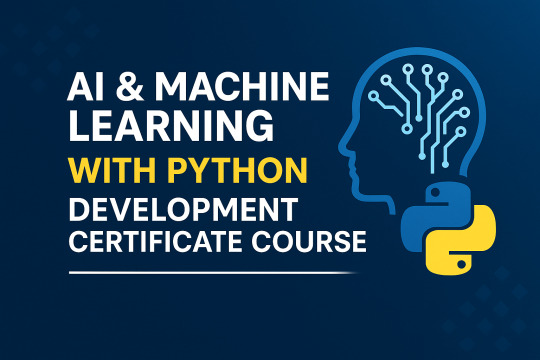
In 2025, tech skills are evolving faster than ever — and Python has become the top programming language powering the future of artificial intelligence and machine learning. Whether you're a beginner or looking to upskill, learning Python for AI and ML could be the career move that sets you apart in this competitive job market.
Key benefits of learning python for AI & ML in 2025
Future-Proof Skill
As automation and AI become integral to every industry, Python fluency gives you a competitive edge in an AI-first world.
Beginner-Friendly Yet Powerful
You don’t need a computer science degree to learn Python. It’s perfect for non-tech professionals transitioning into tech careers.
Freelance and Remote Opportunities
Python developers working in AI and ML are in high demand on platforms like Upwork and Toptal many command salaries above six figures, working remotely.
Community and Resources
With massive open-source support, free tutorials, and active forums, you can learn Python for AI even without formal education.
Create roadmap: python for Ai and Machine learning
Master the Basics Start with variables, data types, loops, functions, and object-oriented programming in Python.
Understand Data Science Foundations Learn to work with Pandas, NumPy, and Matplotlib for data preprocessing and visualization.
Dive into Machine Learning Explore supervised and unsupervised learning using Scikit-learn, then graduate to TensorFlow and PyTorch for deep learning.
Build Real Projects Hands-on experience is key. Start building real-world applications like:
Spam email classifier
Stock price predictor
Chatbot using NLP
Why python is the best language for AI & Machine learning
Python's simplicity, vast libraries, and flexibility make it the best programming language for artificial intelligence. With intuitive syntax and community support, it's a favorite among data scientists, developers, and AI engineers.
✅ High-demand Python libraries in AI:
TensorFlow and Keras – deep learning models
Scikit-learn – machine learning algorithms
Pandas & NumPy – data analysis and manipulation
Matplotlib & Seaborn – data visualization
These tools allow developers to build everything from predictive models to smart recommendation systems all using Python.
Career Opportunities After Learning Python for AI
If you're wondering how Python for AI and ML can shape your future, consider this: tech companies, startups, and even non-tech industries are hiring for roles like:
Machine Learning Engineer
AI Developer
Data Scientist
Python Automation Engineer
NLP (Natural Language Processing) Specialist
According to LinkedIn and Glassdoor, these roles are not just high-paying but are also projected to grow rapidly through 2030.
Best courses to learn python for Ai & ML in 2025
Google AI with Python (Free course on Coursera)
Python course With SKILL BABU
IBM Applied AI Certification
Udemy: Python for Machine Learning & Data Science
Fast.ai Deep Learning Courses (Free)
These programs offer certifications that can boost your resume and help you stand out to employers.
Conclusion: Choose Your Best Career with Python in 2025
If you’re looking to stay ahead in 2025’s job market, learning Python for AI and machine learning is more than a smart move , it’s a career game-changer. With endless growth opportunities, high-paying roles, and the chance to work on cutting-edge technology, Python opens doors to a future-proof tech career.
Start today. The future is written in Python.
#python#app development company#PythonForAI#MachineLearning2025#LearnPython#TechCareers#AIin2025#Python Programming#Learn AI in 2025#Machine Learning Career#Future Tech Skills#Python for Beginners
0 notes